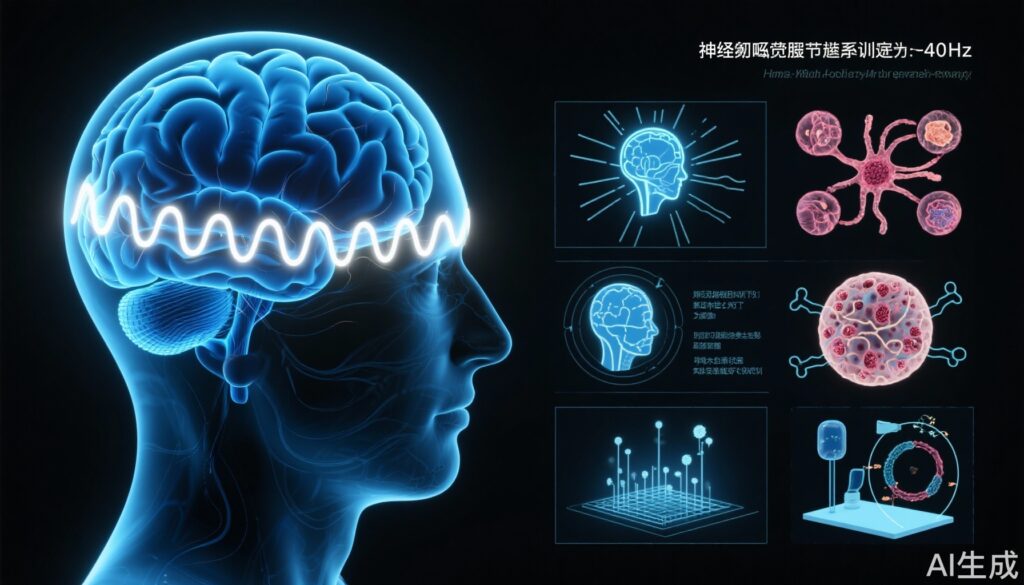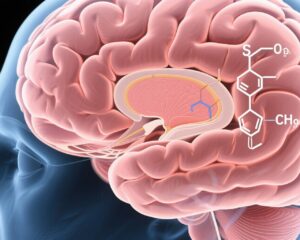Highlights
- 40 Hz light stimulation induces gamma frequency entrainment linked to reductions of amyloid and tau pathology in Alzheimer’s disease (AD) animal models.
- Various sensory modalities, including invisible spectral flicker and sound, effectively elicit 40 Hz neural entrainment, with emerging data on comparative tolerability and feasibility.
- Early-phase clinical trials demonstrate safety, good adherence, and potential cognitive benefits with 40 Hz light-based neurostimulation in mild-to-moderate AD patients, alongside structural brain changes suggestive of slowed neurodegeneration.
- Mechanistic insights implicate modulation of microglial activity, neuroinflammation, and neural network connectivity, supporting further trials for therapeutic translation.
Background
Alzheimer’s disease (AD) is a progressive neurodegenerative disorder characterized by cognitive decline, amyloid-beta plaques, neurofibrillary tau tangles, and neuroinflammation. Conventional pharmacotherapies provide only symptomatic relief, and there is a critical unmet need for interventions that modify disease progression.
Gamma oscillations (~40 Hz) are brain rhythms involved in cognitive processes such as attention and memory. Dysregulation of gamma activity has been implicated in AD pathogenesis. Recently, non-invasive induction of gamma oscillations via sensory stimulation at 40 Hz has emerged as a promising strategy to modulate AD pathology by leveraging endogenous neural plasticity mechanisms.
Key Content
Mechanistic Basis of 40 Hz Light Stimulation in AD
Experimental evidence suggests that 40 Hz sensory stimulation entrains gamma oscillations in cortical and subcortical regions including the hippocampus, amygdala, and insula, promoting beneficial neuroimmune interactions. Specifically, gamma entrainment enhances microglial phagocytic activity, leading to amyloid-beta clearance and reduction in tau pathology. It also reduces neuroinflammation and protects synaptic function, potentially slowing neurodegeneration.
Comparative Analysis of Light Wavelength and Stimulation Modalities
Studies have utilized various forms of light stimulation, including visible flickering light and invisible spectral flicker (ISF), as well as combined light and sound stimuli. Invisible spectral flicker designed at 40 Hz reduces discomfort associated with prolonged flicker exposure, improving participant adherence.
Auditory 40 Hz stimulation has also been explored, showing cognitive and behavioral benefits in AD patients but may differ in patient tolerability compared to visual stimulation. Converging evidence indicates that multimodal gamma entrainment (light plus sound) may enhance efficacy by stimulating broader neural networks.
Preclinical Evidence from Animal Models
Mouse models of AD subjected to daily 40 Hz sensory stimulation exhibit significantly reduced amyloid and tau load, decreased brain atrophy, and improved cognitive performance. Gamma entrainment restored disrupted neural network oscillations and functional connectivity, reinforcing the rationale for translational development.
Clinical Trials and Human Studies
Three key studies illustrate the current clinical landscape:
1. A 2023 randomized, placebo-controlled, double-blinded pilot trial assessed safety and feasibility of 40 Hz invisible spectral flicker (ISF) in mild-to-moderate AD patients (n=11). High adherence (>86%) and minimal adverse events were reported. While cognitive improvements were not statistically significant at 6 weeks, trends favored the active group. Notably, after 12 weeks, hippocampal volume increased and ventricular volume decreased in the treatment group compared to placebo, suggesting a delayed neuroprotective effect.
2. A 2022 Phase 1 and Phase 2A study with mild AD dementia patients used combined 40 Hz light and sound stimulation daily for 3 months. Safety and compliance were excellent. EEG confirmed effective 40 Hz entrainment, including deep brain structures. Treated patients exhibited reduced ventricular dilation, attenuated hippocampal atrophy, enhanced default mode and medial visual network functional connectivity, and improved memory recall tests versus controls.
3. A 2016 exploratory pilot study examined 40 Hz auditory stimulation in mild, moderate, and severe AD across multiple sessions. Significant cognitive benefits, measured by the St. Louis University Mental Status Test, were observed mainly in mild and moderate patients. Visual stimulation via DVDs was ineffective, emphasizing the importance of specific rhythmic sensory input.
Collectively, these studies support the safety and potential efficacy of 40 Hz sensory stimulation, with emerging evidence of structural brain benefits and improved cognitive outcomes.
Expert Commentary
The convergence of mechanistic, preclinical, and early clinical data underscores 40 Hz light stimulation as a compelling neuromodulatory approach in AD. Importantly, invisible spectral flicker may overcome adherence barriers posed by perceptible flickering, highlighting the role of stimulus design.
Limitations include small sample sizes, short trial durations, and preliminary efficacy signals requiring validation in larger, longer-term randomized controlled trials. The optimal stimulation parameters (intensity, duration, modality combinations) remain to be refined.
From a mechanistic perspective, gamma entrainment’s ability to engage neural and immune pathways offers a novel disease-modifying avenue distinct from standard pharmacotherapies. Enhanced functional connectivity especially in the default mode network may correlate with cognitive preservation.
Clinically, integrating 40 Hz light stimulation may complement established therapies, potentially delaying progression in early-stage AD. However, real-world effectiveness, long-term safety, and scalability must be demonstrated.
Conclusion
40 Hz light stimulation represents an innovative, non-invasive strategy targeting neural circuit dysfunction and pathological hallmarks of Alzheimer’s disease. Mechanistic insights into gamma entrainment, coupled with encouraging preclinical and emerging clinical data, motivate larger pivotal trials. Future research should delineate optimal stimulus parameters, explore multimodal sensory combinations, and clarify patient selection criteria to maximize therapeutic impact.
References
- Bluhm et al. Safety, Feasibility, and Potential Clinical Efficacy of 40 Hz Invisible Spectral Flicker versus Placebo in Patients with Mild-to-Moderate Alzheimer’s Disease: A Randomized, Placebo-Controlled, Double-Blinded, Pilot Study. J Alzheimers Dis. 2023;92(2):653-665. doi:10.3233/JAD-221238. PMID: 36776073.
- Chan et al. Gamma frequency sensory stimulation in mild probable Alzheimer’s dementia patients: Results of feasibility and pilot studies. PLoS One. 2022 Dec 1;17(12):e0278412. doi:10.1371/journal.pone.0278412. PMID: 36454969.
- D’Cunha et al. Short-Term Effects of Rhythmic Sensory Stimulation in Alzheimer’s Disease: An Exploratory Pilot Study. J Alzheimers Dis. 2016 Mar 25;52(2):651-60. doi:10.3233/JAD-160081. PMID: 27031491.



